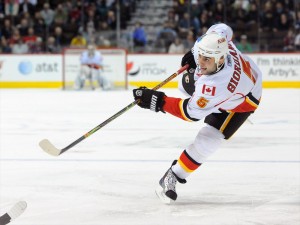The hockey world was abuzz throughout the season, with much of the chatter focusing on the surprising Calgary Flames.

In just the second season of their rebuild, the Flames displayed some solid progression. They made the post-season for the first time since 2009 and won a playoff round for the first time since 2004. Some onlookers have mistaken Calgary’s modest forward movements for a gigantic leap, with occasional jokes about the team skipping steps in their rebuild.
The Flames didn’t make a giant leap. They made a big step forward, though.
The 2012-13 edition of the Flames were, in a word, slow. The club was high on experience, low on speed, and low in the standings. Beginning with the trading away of Jarome Iginla, the team began emphasizing speed and size – first with Jay Feaster, then with interim general manager Brian Burke, then with new GM Brad Treliving.
The 2013-14 edition of the Flames were, in another word, disjointed. The team suffered from key injuries throughout the year, including losing Sean Monahan, Mark Giordano and others for long stretches. As a result, team continuity wasn’t really there, systems were a tad disjointed and the team didn’t really gel until Christmas. The up-shot was that the team was way, way out of the Stanley Cup playoff race by the time the calendar flipped over to 2014 and the club got healthy. The result was the team figured things out, gelled as a group and managed to go on an excellent run throughout the late part of the season. The 2013-14 Flames weren’t nearly as bad as their record indicated, as they were terribly unlucky in terms of bounces and injuries to key players at bad times.
The 2014-15 edition of the Flames were generally pretty lucky. Outside of Mark Giordano’s late-season injury, the team never really lost a big piece from their line-up. The Flames also frequently were out-shot (44 times) and gave up the first goal a lot (46 times), yet still finished in a playoff spot. How? They relied a lot on comebacks and their overtime record.
- They trailed 30 times after one period, and posted a 13-14-3 record.
- They trailed 34 times after two periods, and posted a 10-20-4 record. Only Detroit and Anaheim had more late-game wins.
- They went to extra time on 20 occasions, and won 13 times.
Now, do any of these three strategies – getting out-shot, giving up goals and going to overtime a lot – sound sustainable? No, probably not. The Flames were pretty lucky at times, and managed to pull rabbits out of their hat time and time again. It likely won’t happen again next season.
Despite these pronouncements, the Calgary Flames are charting in the right direction. The team has a culture, and has developed an aggressive puck pursuit system. Their playoff experience will benefit the team in two key ways: their young players will be able to take some lessons away from their struggles, and the team’s management will be better able to identify key holes and redundancies in their roster.
Two years ago, the Flames were not particularly good. They blew the team up. They began a rebuild. Last season, the Flames were unlucky, injury-prone and not quite as bad as their record indicated. This season’s Flames were impressive, but expectations for the near future should likely be lowered because of their reliance on comebacks and luck. They weren’t quite as good as their record, but they’re miles ahead of where they were before the rebuild began.